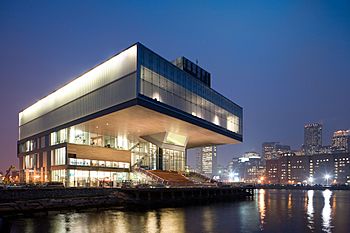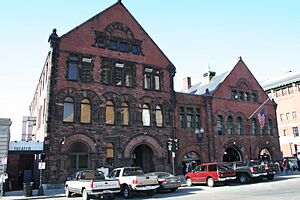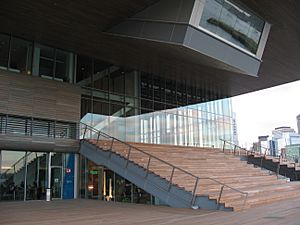Institute of Contemporary Art, Boston facts for kids
 |
|

The ICA's current building in South Boston
|
|
| Former name | Boston Museum of Modern Art |
|---|---|
| Established | 1936 |
| Location | 25 Harbor Shore Drive, Boston, MA 02210 |
| Type | Art museum |
| Accreditation | American Alliance of Museums |
| Architect | Diller Scofidio + Renfro |
| Public transit access |
Silver Line (SL1 or SL2)
Courthouse Station |
The Institute of Contemporary Art (ICA) is a cool art museum in Boston, Massachusetts. It's a place where you can see amazing modern art and special shows.
The museum started in 1936 as the Boston Museum of Modern Art. Over the years, it changed its name a few times. It also moved its art galleries and offices more than 13 times!
The ICA's current home was built in 2006. It's located in the South Boston Seaport District. The building was designed by famous architects Diller Scofidio + Renfro.
Contents
History of the ICA

The Institute of Contemporary Art began as the Boston Museum of Modern Art in 1936. Its first offices were on State Street. The Fogg Museum and the Busch–Reisinger Museum at Harvard University helped by providing gallery space.
The museum wanted to be a bit different from the Museum of Modern Art. Its first president was Nathaniel Saltonstall, a 26-year-old architect. The very first art show at the museum featured works by Paul Gauguin.
In its first year, the museum held a fundraiser called the Modern Art Ball. Many famous artists attended, including Gala and Salvador Dalí. They even came dressed as sharks!
Early Years and New Art Styles
In 1937, the Boston Museum of Modern Art moved to its own gallery space on Newbury Street. They started charging 25 cents to get in. That year, the museum showed the first big exhibit of dada and surrealist art. A famous artwork called Object (Le Déjeuner en fourrure) by Méret Oppenheim was part of this show.
In 1938, the museum helped bring the Ballet Russe de Monte-Carlo to the United States for the first time. The stage designs and costumes for the ballet were made by Henri Matisse. This fit with the museum's exhibit at the time, which looked at the art of Matisse and Pablo Picasso. The museum moved again, this time to the Boston Art Club.
In 1939, the museum changed its name to the "Institute of Modern Art." It wanted to show it was independent from the Museum of Modern Art. After this name change, the museum held a show of German art that was called "unwanted" by Hitler. Artists in this exhibit included Max Beckmann and Paul Klee.
In 1940, the museum hosted a traveling show of Pablo Picasso's art. It was called "Picasso, Forty Years of His Art" and included his famous painting Guernica. The museum moved again to Beacon Street. It also put together the first museum show in the United States for architect Frank Lloyd Wright.
The museum stayed on Beacon Street until 1943. Then it moved to Newbury Street. There, it put on the first show in New England featuring African American artists. This exhibit included works by Romare Bearden and Jacob Lawrence. The museum was also important for artists known as the Boston Expressionists.
Becoming the ICA
In 1948, the "Institute of Modern Art" changed its name one more time to the "Institute of Contemporary Art" (ICA). This new name helped show that the museum focused on art that was happening "now." In the same year, the ICA showed works by Le Corbusier. It was his first show in a United States museum.
For the next few years, the ICA had many different art shows. These included a 1950 show of Edvard Munch's art, which featured his famous painting The Scream. In 1952, they showed art by Wassily Kandinsky, including some pieces never seen in the U.S. before. In 1953, they had the first big show looking back at the art of Milton Avery.
In 1956, the museum moved again to the School of the Museum of Fine Arts, Boston. In 1958, it organized the first U.S. museum show for Roberto Matta. In 1959, the ICA put art inside a Stop & Shop store for a show called "Young Talent in New England." Some people think this show was an early example of the pop art movement.
New Locations and Important Shows
In 1960, the ICA moved to the Metropolitan Boston Arts Center. This building was designed by the museum's founder, Nathaniel Saltonstall. It was a modern glass gallery, 80 feet long and 33 feet wide, raised 12 feet off the ground.
The ICA stayed there until 1963, then moved to Newbury Street. During these five years, the museum showed art by American artists who were featured at the Venice Biennale. These artists included Jasper Johns and Robert Rauschenberg. In 1965, the museum had an exhibit about video and electronic art called "Art Turned On." Even Marcel Duchamp attended this show.
In 1966, the museum organized an Andy Warhol exhibition. It had about 40 works, including his famous Campbell's Soup Cans and portraits of famous people like Marilyn Monroe. The museum also showed Warhol's films for the first time in a museum setting. In the same year, Andy Warhol and The Velvet Underground performed their show "Exploding Plastic Inevitable" at the ICA.
In 1968, the ICA returned to the Metropolitan Boston Arts Center for two years. Then, in 1970, it moved to the Parkman House as a temporary home. During these two years, the ICA held an exhibit called "Monumental Sculpture for Public Spaces." Large sculptures by artists like Alexander Calder and Claes Oldenburg were placed in public areas around the city. A very notable sculpture from this exhibit was Robert Indiana's 12-foot-tall LOVE sign, placed on City Hall Plaza.
A Long-Term Home and New Ideas
In 1972, the ICA had its first solo show for Douglas Huebler. It briefly moved to another spot on Newbury Street. A year later, in 1973, the ICA found a more lasting home at 955 Boylston Street. This building used to be a police station.
The museum stayed in this building for 33 years. Many exhibits and performances happened there. Some highlights from the first ten years included a 1976 show for Claes Oldenburg, which Oldenburg himself attended. In 1977, the first show of David Hockney's art in America took place. In 1980, the museum hosted the first U.S. museum show of only Dada artworks. They also had a fun roller disco fundraiser!
The 1980s brought more exciting shows. In 1982, the ICA had the first museum shows for Francesco Clemente and Anselm Kiefer. In 1984, the ICA worked with WGBH, Boston's PBS station. They created a fund to help video artists get their works shown on television.
Later in the 1980s, the ICA showed works by Allan Sekula in his first museum solo show in 1986. They also had the New England premiere of the film True Stories by David Byrne in 1986. Byrne even came to the screening. In 1989, the museum displayed the first U.S. show for Chris Burden.
In 1990, the ICA was the last stop for a traveling exhibit called "The Perfect Moment." It featured works by Robert Mapplethorpe. The museum also showed the first U.S. museum exhibit of works by Sophie Calle. In 1997, Cildo Meireles had his first show in a major U.S. museum at the ICA.
Moving to the Waterfront
The late 1990s brought big changes to the ICA. A new director, Jill Medvedow, was hired. She started a new project called "Vita Brevis." This project involved commissioning large artworks to be shown in public places around Boston. One of the first works was a film projected onto the Bunker Hill Monument. These public art projects helped more people learn about the museum.
Then, in 1999, the ICA won a competition to build a new cultural building. It would be located on Boston's Fan Pier, right on the waterfront.
While plans for the new building were being made and construction was happening, the ICA stayed at its Boylston Street location. During these years, the ICA had the first solo museum show for Cornelia Parker in 2000. It also hosted the first U.S. solo exhibit for Olafur Eliasson in 2001.
In 2006, the ICA moved to its new 65,000-square-foot building on Fan Pier. This new building has both art galleries and a space for performances. In the same year, the museum started to build its own permanent collection of art.
Since moving to its new building, the ICA has hosted world premieres of dance performances. These included shows by the Mark Morris Dance Group in 2007 and the Bill T. Jones/Arnie Zane Dance Company in 2011. Recent exhibits have included the first major museum shows for artists like Tara Donovan in 2008, Damián Ortega in 2009, and Mark Bradford in 2010.
ICA Buildings
Main Building on the Waterfront
The ICA used to be on Boylston Street in the Back Bay area. In 2006, it moved to its new building in the Seaport District of South Boston. The museum celebrated the opening of its new home in December 2006. This new building also marked the start of the museum's first permanent art collection.
The new building was designed by the architecture firm Diller Scofidio + Renfro. It was one of their first buildings to be completed, and their first in the United States. It was also the first new art museum built in Boston in over 100 years!
The building is easy to reach by public transport. It's located between the Courthouse and World Trade Center stations on the MBTA Silver Line.
Many people have praised the building's design. It looks a bit like the gantry cranes used at the nearby harbor. Critics liked its open feel, shown by the large outdoor staircase. They also liked how it connects with the harbor around it. The ICA building won the 2007 Harleston Parker Medal for being "the most beautiful piece of architecture" in Boston.
ICA Watershed
In 2018, the ICA opened a new space called the "ICA Watershed." It's a 15,000-square-foot building in the Boston Harbor Shipyard and Marina in East Boston. This building used to be old and unused, but it was transformed by architects Alex Anmahian and Nick Winton.
It's free to visit the Watershed! The ICA even offers a ferry service from its main building to the Watershed. It's open each year from spring through fall.
Each year, a single artist's work fills the entire space. In 2018, the exhibit was by Diana Thater. In 2019, it was by John Akomfrah. The 2021 season featured work by Firelei Báez. The 2022 exhibit was called "Revival: Materials and Monumental Forms" and showed works by six artists. In 2023, the Watershed featured sculptures by Guadalupe Maravilla. The 2024 season presented Hew Locke's work "The Procession."
Exhibitions and Programs

The ICA has many different types of exhibitions and programs:
- Momentum series: This focuses on the work of new and rising artists.
- Sandra and Gerald Fineberg Art Wall: Each year, an artist creates a special artwork just for the museum lobby.
- James and Audrey Foster Prize: This is a show and award that happens every two years for artists from the Boston area.
- Permanent Collection: The museum also shows selected works from its own growing art collection.
The largest exhibition space is called the West Gallery. It has featured many solo and group shows. Some past highlights include:
- Super Vision (2006)
- Philip-Lorca diCorcia (2007)
- Anish Kapoor (2008)
- Tara Donovan (2008)
- Shepard Fairey (2009)
- Mark Bradford (2011)
- Liz Deschenes (2016)
- Mark Dion: Misadventures of a 21st-Century Naturalist (2017)
- William Forsythe: Choreographic Objects (2018-2019)
- Yayoi Kusama: LOVE IS CALLING (2019-2020)
- Virgil Abloh: “Figures of Speech” (2021)
- Simone Leigh (2023)
Leadership
Directors
- 1998–2024: Jill Medvedow
Chief Curators
- 2010–2014: Helen Molesworth
- 2015–2023: Eva Respini
- 2023–present: Ruth Erickson
See also
 In Spanish: Instituto de Arte Contemporáneo (Boston) para niños
In Spanish: Instituto de Arte Contemporáneo (Boston) para niños


